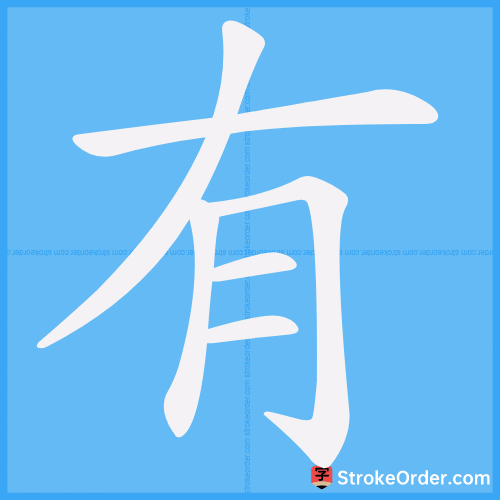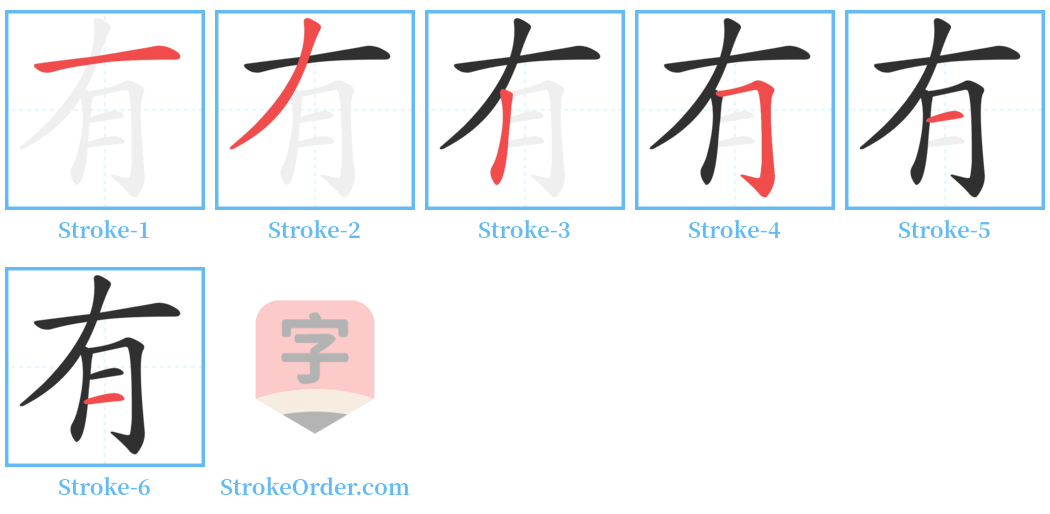有 Stroke Order
Animated Stroke Order of 有

Stroke Order Diagrams for 有

Step-by-Step Handwriting Guide for 有

Learn to Write Chinese Characters with Video Tutorials
Watch the video of writing the Chinese character "有", learn the correct stroke order (笔顺) of the character "有", and master the standard way of writing the character "有".

Free Printable Handwriting Practice with Stroke Order: 有
Printable Writing Practice Worksheet of "有" in Portrait Orientation (Tian Zi Ge)

Printable Writing Practice Worksheet of "有" in Landscape Orientation (Tian Zi Ge)

Information of 有
Pinyinyǒu、 yòu
Radical
月
Strokes
6 strokes
Usage
★★★★★
Definition
to have / there is / there are / to exist / to be
有 [yǒu]1. 存在: to exist.2. 表示所属: to indicate possession.3. 表示发生、出现: to indicate occurrence or appearance.4. 表示估量或比较: to indicate estimation or comparison.5. 表示大、多: to indicate magnitude or plurality.6. 用在某些动词前面表示客气: used before certain verbs to express politeness.7. 无定指,与“某”相近: indefinite reference, similar to "some".8. 词缀,用在某些朝代名称的前面: a prefix used in the names of certain dynasties. Examples: 1. 存在: ~关 (there is a concern). ~方(得法)(there is a method). ~案可稽 (there are cases to reference). ~备无患 (if prepared, there is no worry). ~目共睹 (there is common witness).2. 表示所属: 他~一本书 (He has a book).3. 表示发生、出现: ~病 (to get sick). 情况~变化 (the situation is changing).4. 表示估量或比较: 水~一丈多深 (the water is more than ten feet deep).5. 表示大、多: ~学问 (to have great knowledge).6. 用在某些动词前面表示客气: ~劳 (to trouble). ~请 (please).7. 无定指,与“某”相近: ~一天 (one day).8. 词缀,用在某些朝代名称的前面: ~夏 (the Xia dynasty). ~宋一代 (the Song dynasty period).有 [yǒu] (verb)1. 同本义 (same basic meaning): to have; possess.2. 存在 (to exist).3. 取得,获得,占有 (to obtain; to possess).4. 等候,等待 (to wait).5. 发生,呈现;产生 (to happen).Examples:1. 有功 (to have merit).2. 有根有苗 (to have foundation and leads).3. 有理走遍天下 (to go anywhere with logic).4. 有时节 (to have a time).5. 有盼头 (to have hope; bright future).有 [yǒu] (adjective)1. 用在“人”、“时候”、“地方”前面,表示一部分 ([En.] some): 有人说可以 (some people say it is possible).2. 表示不定指 ([En.] one): 有一天他来我家 (one day he came to my home).3. 表示过去有一段 ([En.] means a certain time in the past): 有一年 (one year), 有一天 (one day).有 [yǒu] (adverb)1. 用于某些动词前组成套语,表示客气 (used before certain verbs to express politeness): 有请 (please), 有劳 (thank you for your trouble).2. 相当于“或” (equivalent to "or"): 或许 ([En.] perhaps).有 [yòu] (variant)1. 通“又” ([En.] same as “又”).2. 另见 yǒu (see also "有").
have a distinctive flavour
since the beginning of history
Whether
to contain / including
original / former
Another point
only
only
intrinsic to sth / inherent / native
to fail or lose (used in fixed expressions)
to be like sth / similar to / alike
highly effective / fruitful
Outstanding achievement
Zhuo You
to have / to own / to hold / to occupy / to possess / to account for (a high proportion etc)
market share
occupancy
expect everyone to do his duty / Each and everyone should hold himself responsible for his country's welfare. / Every common man has his obligation.
to hold in storage / to retain / to harbor (feelings) / to entertain (sentiments) / (of abstract things) to exist / there is
destructive / harmful / damaging
rich / full of
having a sense of propriety / knowing how far to go and when to stop
more
non-ferrous metals (all metals excluding iron, chromium, manganese and their alloys)
how can this be so? (idiom); preposterous / ridiculous / absurd
refined and courteous / urbane
to take for one's own / to expropriate
already have
to have / to involve
often
Input Method for 有
Pinyinyou3
Wubi
def
Cangjie
kb
Zhengma
gdq
Four Corner
40227
Unicode
U+6709
Same Pronunciation Characters
优佑又友右尤幼幽忧悠有油游犹由诱迂邮酉侑卣呦囿宥攸柚牖猷疣莜莠莸蚰蚴蝣釉铀鱿黝鼬優尢憂懮斿猶蕕誘迶遊郵鈾铕魷泑怮麀滺鄾嚘瀀櫌耰纋沋肬怞怣莤逌峳秞浟逰偤訧楢鲉駀輏輶鮋櫾邎苃丣羑羐庮聈梄脜蒏湵蜏禉銪牗狖
Same Radical Characters
月有朋服朗望朝期肋肌肖肘肚肛肝肠股肢肤肥肩肪肮肯育肴肺肾肿胀胁胃胆背胎胖胚胜胞胡胧胰胳胶胸能脂脆脉脊脏脐脑脓脖脚脯脱脸脾腊腋腔腕腥腮腰腹腺腻腾腿膀膊膏膛膜膝膨臀臂臊朐朔朕肓肟肫肱肼肽胂胄胍胗胙胛胝胤
本文来自呆头呆脑的猪投稿,不代表汉字笔顺中文网英文版立场,如若转载,请注明出处:https://www.strokeorder.cn/strokeorder/18848.html

 微信扫一扫
微信扫一扫 